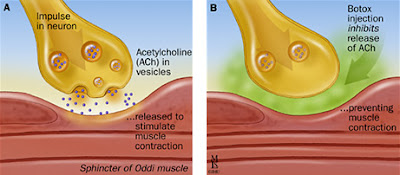Banish crow's feet. Plump up the lips. Tighten sagging jowls.
All are very attractive options—particularly for the aging population, and particularly for those looking for a fast, relatively painless solution with little effort on our part.
But did you know that Botox—the quick fix solicited by 6 million Americans each year and 75% of celebrities over the age of 35—is composed of the same deadly toxin responsible for botulism poisoning that can cause paralysis and respiratory failure? Let's examine the mechanism behind this potentially deadly neurotoxin and why, for goodness' sakes, Botox can be used as a therapeutic despite its dangerous potential.
Botox is the trade name for botulinum toxin, a protein produced by the bacterium Clostridium botulinum (below, left). With a relatively low LD50 of 40 nanograms, botulinum toxin (below, right) is one of the most powerful neurotoxins known today. That means that injecting just 40 ng of the toxin is lethal in 50% of the primate population in which it was tested. To put 40 ng in perspective: a gram is roughly the mass of a paperclip. A nanogram is one billionth of a gram.
  |
Botulism disrupts both voluntary muscle control and the autonomic nervous system. Symptoms of poisoning include double vision, eyelid drooping, loss of facial expression, inability to swallow, constipation, nausea, and difficulty talking. Weakness spreads throughout the body, making it difficult to use the limbs. Eventually, severe botulism can result in paralysis of respiratory muscles, leading to respiratory arrest, coma, and death if untreated. Treatment includes immediate removal of food-borne contamination by inducing vomiting, followed by treatment with a horse-derived antitoxin that functions to block the action of circulating botulinum.
So...pretty dangerous, right? Though, at this point, you've likely made the connection between Botox and facial paralysis—after all, we've all seen Joan Rivers.
Let's take a look at the mechanism by which botulinum exerts its tenacious control over the nervous system.
The heavy chain of the toxin (represented in green in the figure above) is responsible for targeting axon terminals, the ends of neurons where neurotransmitters are released. Once attached, the toxin is gobbled up by the neuron via endocytosis, by which a vesicle forms around the toxin and allows it to enter the cell.
The light chain of the toxin (represented in purple above) functions to cleave (disrupt the structure of) a protein called SNARE. Typically, SNARE allows neurotransmitter-containing vesicles to "dock" at the axon terminal and release neurotransmitter.
In short, botulinum toxin inhibits neurotransmitter release from the axon terminal of a neuron, blocking communication. In muscles, release of the neurotransmitter acetylcholine allows muscle contraction and movement (left). When this effect is blocked, paralysis occurs—the hallmark of botulism poisoning (right).
Botox injections are performed by doctors to treat a range of ailments: dystonia, migraine, severe sweating, and cosmetic correction, among others. Effects can last up to four months.
The concentration of Botox injected in patients is around 0.75 ng per 100 units, or roughly 1/5 of the estimated lethal dose in humans.
But take heed: Botox injections may spread beyond the injection site, and are not for women who are pregnant, breastfeeding, or with neuromuscular or motor neuron diseases. Post-injection, 10% of patients experience eyelid drooping and blurred vision, and 60% of patients may have difficulty swallowing for up to a week after the procedure.
So the next time you see your favorite celebrity post-injection, looking particularly smooth-skinned and pouty-lipped, remember that they injected a deadly toxin into their body and likely had difficulty enjoying food for a couple days—all so that they could look younger just for you, adoring fan.
Images courtesy LA Times, Human Healths, Access Medicine, Connexions, JHU, CBS, and The Gloss.
Arnon, S. (2001). Botulinum Toxin as a Biological Weapon: Medical and Public Health Management JAMA: The Journal of the American Medical Association, 285 (8), 1059-1070 DOI: 10.1001/jama.285.8.1059
Frevert J (2010). Content of botulinum neurotoxin in Botox®/Vistabel®, Dysport®/Azzalure®, and Xeomin®/Bocouture®. Drugs in R&D, 10 (2), 67-73 PMID: 20698714






I am your adoring fan now. Thanks for the informative post.
ReplyDeleteThanks for the kind words!
ReplyDeleteAs a stroke survivor, botox is common, I've also had alcohol injections so am curious what the difference is.
ReplyDeleteEven better is that cell and molecular biologists learned that SNAREs exist because they were examining the mechanism by which botulism functions!
ReplyDeleteI made a four part tutorial on the science of botox for my pre-medical students and the general public at http://www.youtube.com/watch?v=FJ5HIWRV2t4